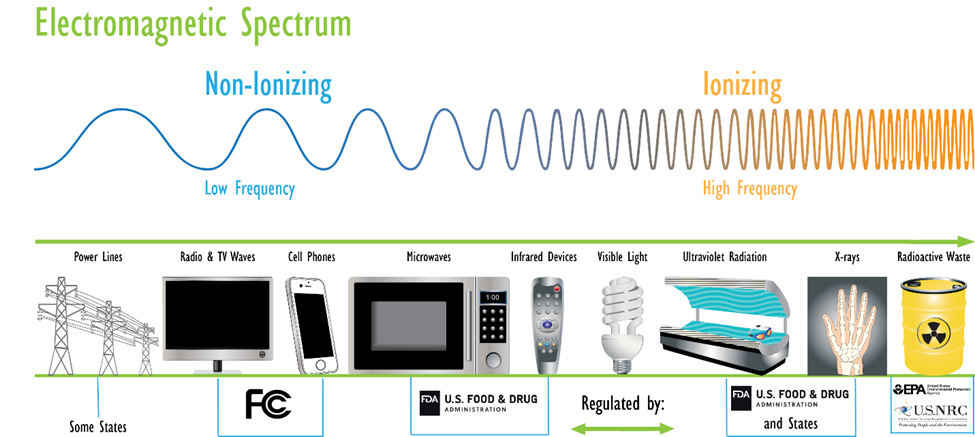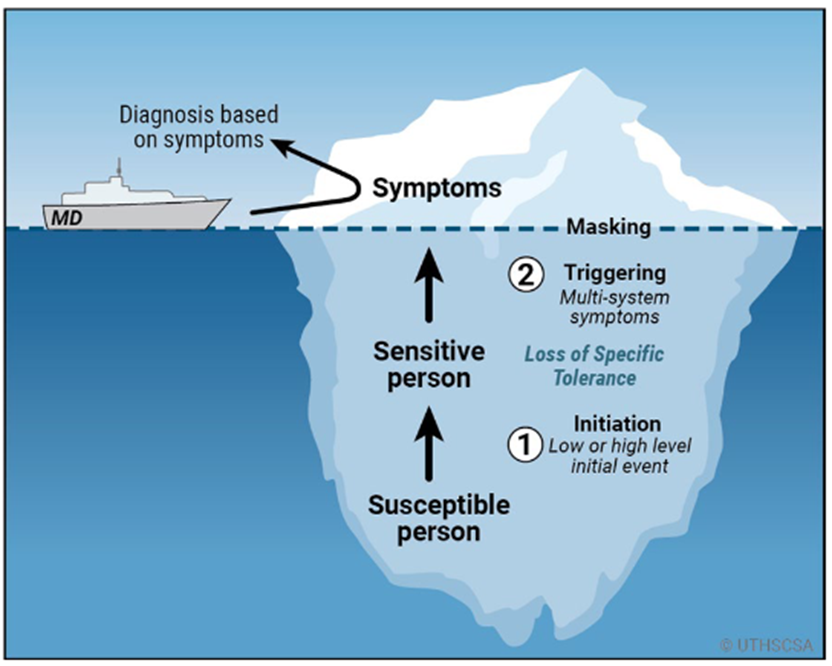EMFs are a form of radiation
The electromagnetic spectrum includes both non-ionizing and ionizing radiation. Non-ionizing radiation is low frequency and is emitted from power lines, radio and TV waves, cell phones, microwaves, infrared devices, and UV, infrared, and visible light. Ionizing radiation is high frequency and includes x-rays, alpha particles, beta particles, and gamma rays.

Source: EPA Electromagnetic Spectrum. https://www.epa.gov/radiation/radiation-basics
Electromagnetic radiation can negatively affect humans, which are bioelectrical entities by nature. Ionizing radiation can cause acute and dramatic adverse effects, while non-ionizing radiation may cause more subtle adverse effects. Some individuals respond differently to various electromagnetic frequencies, with symptoms ranging from mood to cardiac and skin changes. This phenomenon is referred to as electromagnetic hypersensitivity. Exposure to non-ionizing electromagnetic radiation (EMR) and electromagnetic fields (EMFs) is increasing significantly as we enter the 21st century. Exposure comes from three general sources (Genuis 2012):
-
Extremely low EMR from electronic equipment and power lines
-
Very low to low EMR from electrical pollution (“dirty” electricity) that emanates from variable-speed motors and some energy-efficient appliances
-
Microwave and radio frequencies from wireless phones, cell towers, antennae, and broadcast transmission towers
Specific sources of man-made EMFs include:
-
Cell phones, smartphones, tablets
-
Computers
-
Cordless phones
-
Electric appliances
-
Fluorescent lights
-
Handheld electronic devices, including hair dryers, electric toothbrushes, etc.
-
High-voltage power lines and substations
-
Household power, “dirty” electricity
-
Televisions, plasma TVs
-
Transmission towers (cell towers, radar towers, etc.)
-
Utility neutral-to-ground bonded to water pipes
-
Wireless internet
Common signs and symptoms of electromagnetic hypersensitivity:
-
Blurred vision
-
Chest discomfort
-
Dizziness
-
Fatigue
-
General malaise
-
Headache
-
Heart palpitations
-
Memory impairment
-
Muscle pain
-
Nausea
-
Night sweats
-
Paresthesia
-
Restless legs
-
Sleep disorder
-
Thought processing difficulties
-
Tinnitus
-
Weakness
EMF exposure is associated with oxidative stress, which can explain some of its adverse effects, including altered hemoglobin, damaged RBCs, hypoxia, and anemia. These effects can be exacerbated by the combination of lead and EMF exposure (Ansarihadipour 2016).
The TILT phenomenon
Electromagnetic hypersensitivity may be triggered by exposure to and bioaccumulation of toxic chemicals, pesticides, heavy metals, surgical implants, dental materials, infections, and radioactive compounds. This body burden of toxins can lead to a toxicant-induced loss of tolerance (TILT), a phenomenon associated with impaired immune tolerance, hypersensitivity, altered catecholamine and neurotransmitter metabolism, impaired detoxification, and a dysregulated immune response. Once a certain threshold has been reached, a relatively small amount of exposure can trigger systemic signs and symptoms (Genuis 2012).
The TILT phenomenon was investigated in a review of eight major exposure events shared by a defined population, including:
-
Workers at U.S. Environmental Protection Agency (EPA) headquarters during renovations
-
Exposed to SVOC chemicals in new carpeting
-
-
Gulf War veterans
-
Exposed to organophosphate pesticides, organophosphate nerve agents, e.g., sarin, burn pits, oil well fires, and the drug pyridostigmine bromide
-
-
Pesticide exposure among casino workers
-
Exposure to carbamate and pyrethroid pesticides as well as solvent carriers, including acetone and xylene
-
-
Exposure to aircraft oil fumes
-
Contamination of cabin air by strong odors and fumes, likely from synthetic jet oil, hydraulic fluid, and deicing chemicals
-
-
The World Trade Center tragedy
-
Dust samples from the wreckage revealed a complex mixture, including polycyclic aromatic hydrocarbons (PAHs), pesticides (e.g., organochlorides), asbestos, PCBs, dioxins, phthalates, and brominated fire retardants
-
-
Surgical implants
-
Exposure to silicone and metals
-
-
Moldy environments
-
Exposure to mold toxins, mycotoxins, and mold VOCs, including hydrocarbons, acids, alcohols, aldehydes, aromatics, ketones, etc.
-
-
Tunnel workers exposed to solvents
-
Exposed to contaminated soil containing gasoline, benzene, diesel exhaust, and carbon monoxide
-
Results: Mixed volatile and semi-volatile organic compounds (VOCs and SVOCs), followed by pesticides and combustion products, were the most commonly associated with TILT initiation. Specific chemicals included pesticides, peroxides, nerve agents, anti-nerve agent drugs, lubricants and additives, xylene, benzene, and acetone. The TILT phenomenon appears to correspond to the dramatic expansion of petrochemical use following World War II, including agricultural organophosphate pesticides, solvents, dyes, and fragrances. Once TILT has occurred, individuals can become increasingly sensitive and intolerant to the smell of gasoline, perfume, cleaning compounds, pesticides, and even newsprint (Masri 2021).
The Phenomenon of TILT

Source: Masri, Shahir, et al. "Toxicant-induced loss of tolerance for chemicals, foods, and drugs: assessing patterns of exposure behind a global phenomenon." Environmental Sciences Europe 33.1 (2021): 1-19. This article is licensed under a Creative Commons Attribution 4.0 International License, http://creativecommons.org/licenses/by/4.0/.
A meta-analysis of 15 studies supports the hypothesis that EMFs may contribute to chronic physiological stress, psychiatric disorders, and abnormalities of the cardiovascular system, which is especially susceptible to EMFs. The analysis found that man-made EMF exposure was associated with heart rate variability (HRV) changes that indicate increased sympathetic dominance, decreased resilience to stress and increased susceptibility to anxiety disorders, autonomic dysrhythmias, chronic fatigue, etc. (Mansourian 2023).
Another study examined heart rate variability changes in 30 young, healthy volunteers exposed to EMFs from 2400 MHz wifi. Results demonstrated significantly decreased parasympathetic and significantly increased sympathetic HRV changes, suggesting sympathetic overactivity that can increase the risk of cardiovascular complications in the future. Researchers note that previous long-term studies indicated an association between subjective symptoms, including headache, difficulty concentrating, forgetfulness, excessive irritability, eye inflammation, and high- and low-frequency EMF exposure (Parizek 2023).
Research also suggests long-term chronic non-ionizing EMF exposure can disrupt the orientation, migration, food finding, and reproduction of other species, including mammals, birds, insects, amphibians, reptiles, microbes, and many plant species (Levitt 2021).
References
Ansarihadipour, Hadi, and Mohamadreza Bayatiani. “Influence of Electromagnetic Fields on Lead Toxicity: A Study of Conformational Changes in Human Blood Proteins.” Iranian Red Crescent medical journal vol. 18,7 e28050. 31 May. 2016, doi:10.5812/ircmj.28050
EPA Electromagnetic Spectrum. https://www.epa.gov/radiation/radiation-basics
Genuis, Stephen J, and Christopher T Lipp. “Electromagnetic hypersensitivity: fact or fiction?.” The Science of the total environment vol. 414 (2012): 103-12. doi:10.1016/j.scitotenv.2011.11.008
Levitt, B Blake et al. “Effects of non-ionizing electromagnetic fields on flora and fauna, Part 2 impacts: how species interact with natural and man-made EMF.” Reviews on environmental health vol. 37,3 327-406. 8 Jul. 2021, doi:10.1515/reveh-2021-0050
Mansourian, Mahsa et al. “Effects of man-made electromagnetic fields on heart rate variability parameters of general public: a systematic review and meta-analysis of experimental studies.” Reviews on environmental health, 10.1515/reveh-2022-0191. 18 May. 2023, doi:10.1515/reveh-2022-0191
Masri, Shahir, et al. "Toxicant-induced loss of tolerance for chemicals, foods, and drugs: assessing patterns of exposure behind a global phenomenon." Environmental Sciences Europe 33.1 (2021): 1-19.
Parizek, D et al. “Electromagnetic fields - do they pose a cardiovascular risk?.” Physiological research vol. 72,2 (2023): 199-208. doi:10.33549/physiolres.934938
Sears, Margaret E, and Stephen J Genuis. “Environmental determinants of chronic disease and medical approaches: recognition, avoidance, supportive therapy, and detoxification.” Journal of environmental and public health vol. 2012 (2012): 356798. doi:10.1155/2012/356798







